Art rock
| Art rock | |
|---|---|
| Stylistic origins | |
| Cultural origins | 1960s, United States and United Kingdom |
| Derivative forms | |
| Other topics | |
Art rock is a subgenre of rock music that generally reflects a challenging or avant-garde approach to rock, or which makes use of modernist, experimental, or unconventional elements. Art rock aspires to elevate rock from teen entertainment to an artistic statement,[7] opting for a more experimental and conceptual outlook on music.[3] Influences may be drawn from several genres, such as experimental rock, avant-garde music, classical music, and jazz.[1]
Its music was created with the intention of listening and contemplation rather than for dancing,[3] and is often distinguished by the use of electronic effects and easy listening textures far removed from the propulsive rhythms of early rock.[7] The term may sometimes be used interchangeably with "progressive rock", though the latter is instead characterized in particular by its employment of classically trained instrumental technique and symphonic textures.
The genre's greatest level of popularity was in the early 1970s through British artists. The music, as well as the theatrical nature of performances associated with the genre, was able to appeal to artistically inclined adolescents and younger adults, especially due to its virtuosity and musical/lyrical complexity.[3] Art rock is most associated with a certain period of rock music, beginning in 1966–67 and ending with the arrival of punk in the mid 1970s.[8] After, the genre would be infused within later popular music genres of the 1970s–90s.[3]
Definitions
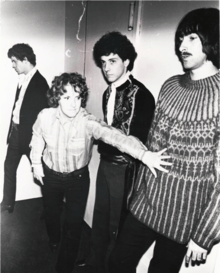
Critic John Rockwell says that art rock is one of rock's most wide-ranging and eclectic genres with its overt sense of creative detachment, classical music pretensions, and experimental, avant-garde proclivities.[9] The term is often used synonymously with progressive rock.[10][9][1][3] Historically, "art rock" has been used to describe at least two related, but distinct, types of rock music.[11] The first is progressive rock, while the second usage refers to groups who rejected psychedelia and the hippie counterculture in favor of a modernist, avant-garde approach defined by the Velvet Underground.[11] Essayist Ellen Willis compared these two types:
From the early sixties … there was a counter-tradition in rock and roll that had much more in common with high art—in particular avant-garde art—than the ballyhooed art-rock synthesis [progressive rock]; it involved more or less consciously using the basic formal canons of rock and roll as material (much as pop artists used mass art in general) and refining, elaborating, playing off that material to produce … rockand-roll art. While art rock was implicitly based on the claim that rock and roll was or could be as worthy as more established art forms, rock-and-roll art came out of an obsessive commitment to the language of rock and roll and an equally obsessive disdain for those who rejected that language or wanted it watered down, made easier … the new wave has inherited the counter-tradition.[12]
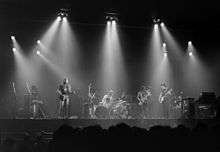
Art rock emphasizes Romantic and autonomous traditions, in distinction to the aesthetic of the everyday and the disposable embodied by art pop.[13] Larry Starr and Christopher Waterman's American Popular Music defines art rock as a "form of rock music that blended elements of rock and European classical music," citing the English rock bands King Crimson, Emerson, Lake & Palmer, and Pink Floyd as examples.[14] Common characteristics include album-oriented music divided into compositions rather than songs, with usually complicated and long instrumental sections, symphonic orchestration.[3] Its music was traditionally used within the context of concept records, and its lyrical themes tended to be "imaginative" and politically oriented.[3]
Differences have been identified between art rock and progressive rock, with art rock emphasizing avant-garde or experimental influences and "novel sonic structure," while progressive rock has been characterized as putting a greater emphasis on classically trained instrumental technique, literary content, and symphonic features.[1] Compared to progressive rock, art rock is "more challenging, noisy and unconventional" and "less classically influenced", with more of an emphasis on avant-garde music.[1] Similarities are that they both describe a mostly British attempt to elevate rock music to new levels of artistic credibility,[1] and became the instrumental analog to concept albums and rock operas, which were typically more vocal oriented.[15]
Art rock can also to refer to either classically driven rock, or a progressive rock-folk fusion.[3] Bruce Eder's essay The Early History of Art-Rock/Prog Rock states that "'progressive rock,' also sometimes known as 'art rock,' or 'classical rock'" is music in which the "bands [are] playing suites, not songs; borrowing riffs from Bach, Beethoven, and Wagner instead of Chuck Berry and Bo Diddley; and using language closer to William Blake or T. S. Eliot than to Carl Perkins or Willie Dixon."[16]
History
1960s
Background
In the late sixties and early seventies, rock both co-opted and challenged the prevailing view of musical art, often at the same time. This is evident in a diverse body of music that includes the Beach Boys' Pet Sounds and the Beatles' Sgt. Pepper; Frank Zappa's Freak Out ... the Who's rock opera Tommy; Pink Floyd's technologically advanced concept album Dark Side of the Moon; and Miles Davis's jazz/rock fusion.
—Michael Campbell, Popular Music in America, 2012[10]
The boundaries between art and pop music became increasingly blurred throughout the second half of the 20th century.[17] The first usage of the term "art rock", according to Merriam-Webster Online Dictionary, was in 1968.[4] As pop music's dominant format transitioned from singles to albums,[nb 1] many rock bands created works that aspired to make grand artistic statements, where art rock would flourish.[19] As it progressed in the late 1960s – in tandem with the development of progressive rock – art rock acquired notoriety alongside experimental rock.[20]
Proponents
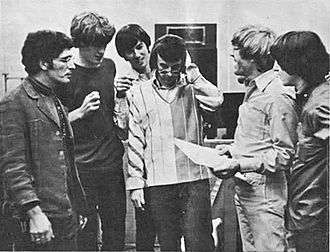
The earliest figure of art rock has been assumed to be record producer and songwriter Phil Spector, who became known as an auteur for his Wall of Sound productions that aspired to a "classical grandiosity".[21] According to biographer Richard Williams: "[Spector] created a new concept: the producer as overall director of the creative process, from beginning to end. He took control of everything, he picked the artists, wrote or chose the material, supervised the arrangements, told the singers how to phrase, masterminded all phases of the recording process with the most painful attention to detail, and released the result on his own label."[22] Spector transformed rock music as a performing art to an art which could only exist in the recording studio, which "paved the way for art rock".[23]
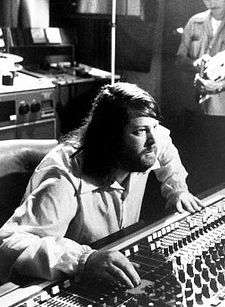
The Beach Boys' leader Brian Wilson is also cited as one of the first examples of the auteur music producer.[24][nb 2] Like Spector, Wilson was known as an eremitic studio obsessive who laboriously produced fantastical soundscapes through his mastery of recording technology.[26] Biographer Peter Ames Carlin wrote that Wilson was the forerunner of "a new kind of art-rock that would combine the transcendent possibilities of art with the mainstream accessibility of pop music".[27] Drawing from the influence of Wilson's work and the work of the Beatles' producer George Martin, music producers after the mid 1960s began to view the recording studio as a musical instrument used to aid the process of composition.[24] Critic Stephen Holden says that Wilson, Spector, and the Beatles are often dated to the beginnings of art pop, which preceded the "bombastic, classically inflected" art rock that started in the late 1960s.[19]
According to journalist Richard Goldstein, many popular musicians from California (like Wilson) desired to be acknowledged as artists, and struggled with this aspiration. Goldstein explains that the line between violating musical conventions and making "truly popular music" caused those who didn't have "strong enough egos" (in contrast to Bob Dylan and the Beatles) to be "doomed to a respectful rejection, and a few albums with disappointing sales usually meant silence. ... They yearned for fame, as only needy people can, but they also wanted to make art, and when both of those impulses couldn’t be achieved they recoiled in a ball of frantic confusion."[28]
Author Matthew Bannister traces "the more self-conscious, camp aesthetic of art rock" to pop artist Andy Warhol and the Velvet Underground, who emulated Warhol's art/pop synthesis.[29] Accordingly: "Warhol took Spector's combination of the disembodiment, 'distance' and refinement of high culture with the 'immediacy' of mass cultural forms like rock and roll several stages further ... But Warhol’s aesthetic was more thoroughly worked out than Spector's, which represented a transitional phase between old-fashioned auteurism and the thoroughly postmodern, detached tenets of pop art. ... Warhol's approach reverberates throughout art rock, most obviously in his stance of distance and disengagement."[30]
Influential albums
Pet Sounds and Freak Out!
Rock's deepest immersion in art began in 1966, the year in which the Beach Boys' Pet Sounds and the Mothers of Invention's Freak Out! were released, and lasted for about a decade.[31] Academic Michael Johnson associates "the first documented moments of ascension in rock music" to Pet Sounds.[32][nb 3] Released in May, Pet Sounds came from Wilson's desire to make a "complete statement", believing that the Beatles' had previously done so with Rubber Soul (1965).[33][nb 4] In 1978, biographer David Leaf wrote that the album heralded art rock,[35] while according to The New York Observer, "Pet Sounds proved that a pop group could make an album-length piece comparable with the greatest long-form works of Bernstein, Copland, Ives, and Rodgers and Hammerstein."[36] Pet Sounds is also noted as the first rock concept album.[37][38][nb 5] In 1971, Cue magazine proclaimed: "In the year and a half that followed Pet Sounds, the Beach Boys were among the vanguard in practically every aspect of the counter culture – psychedelia, art rock, a return to roots, ecology, organic food, [and] the cooled-out sound."[39]
Jacqueline Edmondson's 2013 encyclopedia Music in American Life states that, despite earlier precedents, Frank Zappa and the Mothers of Invention's debut album Freak Out! (June 1966) would be hailed as the first successful incorporation of art music in a pop context, noting that Zappa's Los Angeles locale contained a unique, preexisting avant-garde community that would hold a traceable effect on the rest of his creative work.[17] Writer and pianist Michael Campbell noted that the album "contains a long noncategorical list of Zappa's influences, from classical avant-garde composers to obscure folk musicians".[10]
The Velvet Underground & Nico
Clash Music names the Velvet Underground's debut March 1967 album The Velvet Underground & Nico "the original art-rock record".[40][nb 6] Bannister writes of the Velvet Underground: "no other band exerted the same grip on the minds of 1970s/1980s art/alternative rock artists, writers and audiences."[43] Their influence would recur from the 1970s onwards to various worldwide indie scenes,[43][nb 7] and in 2006, The Velvet Underground & Nico was inducted into the Library of Congress' National Recording Registry, who commented: "For decades [it] has cast a huge shadow over nearly every sub-variety of avant-garde rock, from 70s art-rock to no-wave, new-wave, and punk."[44][nb 8] However, when the Velvet Underground first appeared in the mid 1960s, they faced rejection and were commonly dismissed as a "fag" band.[47]
Sgt. Pepper's Lonely Hearts Club Band
 |
The Beatles – "A Day in the Life"
Campbell believes that "A Day in the Life" from Sgt. Pepper's encapsulates the "art and achievement" of the Beatles through the song's contrasting levels of consciousness, novel features, and stylistic diversity.[48] |
| Problems playing this file? See media help. | |
The Beatles' Paul McCartney deemed Pet Sounds "the record of the time", and in June 1967, the band responded with their own album: Sgt. Pepper's,[49][nb 9] which was also influenced by Freak Out!.[50] AllMusic states that the first wave of art rock musicians were inspired by Sgt. Pepper's and believed that for rock music to grow artistically, they should incorporate elements of European and classical music to the genre.[1][nb 10] Many British groups flowered in the album's wake; those whom are listed in Music in American Life include the Moody Blues, the Strawbs, Genesis, and "most notably", Pink Floyd.[52][nb 11] The band's Roger Waters later stated that both Sgt. Pepper and Pet Sounds "completely changed everything about records" for him[54]
1970s–90s
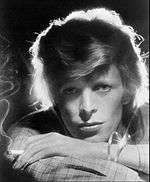
Art rock's greatest level of popularity was in the early 1970s through British artists.[3]
Enthusiasm for art rock explorations waned in the mid 1970s.[10] From then to the 1990s, art rock was infused within various popular music genres.[3] Encyclopædia Britannica states that its genre's tendencies were continued by some British and American hard rock and pop rock artists, and that Brian Eno's late 1970s and early 1980s collaborations with Talking Heads and David Bowie are exemplary of "the successful infusion of art rock tendencies into other popular music genres".[3] Bowie and Eno collaborated on a series of consecutive albums called the "Berlin Trilogy", characterized as an "art rock trifecta" by Consequence of Sound, who noted that at the time of their release, "The experimental records weren’t connecting with audiences on the scale Bowie was used to. ... New Wave had exploded, and a generation of Bowie descendants had taken the stage."[55]
In the 1980s, a new generation of English art rockers took the place of 1970s bands like Yes, Genesis, Jethro Tull and Emerson, Lake & Palmer. Journalist Roy Trakin explains: "Of course, these stalwarts can still fill Madison Square Garden and sell a great many records, as they always have, but their days of adventurous risk-taking and musical innovation are long gone - replaced by the smug satisfaction of commercial success."[56] Trakin identifies XTC as one of the more "accessible" new groups. When the band's Colin Moulding was asked whether he felt the band was closer to art rock or new wave, he responded; "We've always had the art-rock appeal rather than street credibility. ... I'd like to think we're the Vasco de Gamas [sic] of popular music, exploring new grounds. This band has never really been fashionable at all."[56]
Notes
- ↑ The Beatles, the Beach Boys, Phil Spector, and Frank Zappa all indicated a direction that transformed long-playing records into a creative format while variously reciprocating each others' creative developments throughout the 1960s.[18]
- ↑ For an early example of the rock album format being used to make a cohesive artistic statement, author Scott Schinder refers to the album The Beach Boys Today! (1965) and its "suite-like structure", consisting of one side of uptempo songs and the other of ballads.[25]
- ↑ As well as to the Beatles' Sgt. Pepper's Lonely Hearts Club Band (1967).[32]
- ↑ In March 1966, Wilson called Pet Sounds "a more conscious, arty production ... it's like I'm right in the golden age of what it's all about. ... The folk thing has been important. I think it has opened up a whole new intellectual bag for the kids. They're making "thinking" records now. That's really what it is."[34]
- ↑ Carys Wyn Jones observes that Pet Sounds, the Beatles' Revolver (1966) and Sgt. Pepper, and the Who's Tommy (1969) are variously cited as "the first concept album", usually for their "uniform excellence rather than some lyrical theme or underlying musical motif".[8]
- ↑ In late 1966, the Velvet Underground's principal songwriter Lou Reed praised Spector, crowning his "You've Lost That Lovin' Feelin'" (1964) "the best record ever made". In addition, he wrote: "There is no God and Brian Wilson is his son." Reed was also fond of various doo-wop groups, and songwriters of the era such as Holland–Dozier–Holland, Gerry Goffin, Carole King, Jeff Barry, Burt Bacharach, and Hal David.[41] On the Beatles, he said "I never liked [them] ... [they're] garbage".[42]
- ↑ Bannister adds that indie rock musicians would be significantly influenced by the "pop" offshoots of psychedelia that includes the later Beatles, the later Beach Boys, the Byrds, early Pink Floyd, and Love.[11]
- ↑ In 1982, musician Brian Eno famously stated that while The Velvet Underground & Nico initially only sold 30,000 copies, "everyone who bought one of those 30,000 copies started a band.".[45] In 2000, New Times Broward-Palm Beach's Jeff Straton riposted: "In the case of the Beach Boys' 1966 opus Pet Sounds, it's likely that each of its 13 songs inspired its own subset of pop offspring."[46]
- ↑ It is frequently cited for its Pet Sounds influence, as McCartney explains: "If records had a director within a band, I sort of directed Pepper ... and my influence was basically the Pet Sounds album."[49] The interplay between the Beach Boys and the Beatles' creative work thus inextricably links the two albums together.[49]
- ↑ In the Encyclopedia of Popular Music, Colin Larkin wrote of Sgt. Pepper: "[It] turned out to be no mere pop album but a cultural icon, embracing the constituent elements of the 60s' youth culture: pop art, garish fashion, drugs, instant mysticism and freedom from parental control."[51]
- ↑ Pink Floyd recorded their 1967 debut album Piper at the Gates of Dawn next door to the Sgt. Pepper's sessions at London's EMI Studios. Fans believe that the Piper track "Pow R. Toc H." would derive from Pepper's "Lovely Rita", whose sessions Pink Floyd were witness to.[53]
References
- 1 2 3 4 5 6 7 8 9 "Pop/Rock » Art-Rock/Experimental » Prog-Rock". AllMusic.
- ↑ O'Brien, Lucy M. "Psychedelic rock". Encyclopedia Britannica. Retrieved 3 December 2016.
- 1 2 3 4 5 6 7 8 9 10 11 12 "Art Rock". Encyclopædia Britannica. Retrieved 15 December 2011.
- 1 2 "Art-Rock". Merriam Webster. Retrieved 15 December 2011.
- ↑ Hegarty & Halliwell 2011, p. 224.
- ↑ Reynolds 2005, p. 4.
- 1 2 Campbell 2012, p. 393.
- 1 2 Jones 2008, p. 49.
- 1 2 Edmondson 2013, p. 146.
- 1 2 3 4 Campbell 2012, p. 251.
- 1 2 3 Bannister 2007, p. 37.
- ↑ Bannister 2007, pp. 37–38.
- ↑ Frith & Horne 2016, p. 98.
- ↑ "Key Terms and Definitions". Archived from the original on 3 May 2008. Retrieved 16 March 2008.
- ↑ Campbell 2012, p. 845.
- ↑ Eder, Bruce, "The Early History of Art-Rock/Prog Rock", All-Music Guide Essay, Vanguar Church.
- 1 2 Edmondson 2013, p. 1233.
- ↑ Julien 2008, pp. 30, 160.
- 1 2 Holden, Stephen (28 February 1999). "MUSIC; They're Recording, but Are They Artists?". The New York Times. Retrieved 17 July 2013.
- ↑ Rosenberg 2009, p. 179.
- ↑ Bannister 2007, p. 48.
- ↑ Williams 2003, pp. 15–16.
- ↑ Williams 2003, p. 38.
- 1 2 Edmondson 2013, p. 890.
- ↑ Schinder 2007, p. 111.
- ↑ Bannister 2007, p. 39.
- ↑ Carlin, Peter Ames (March 25, 2001). "MUSIC; A Rock Utopian Still Chasing An American Dream". The New York Times.
- ↑ Goldstein, Richard (April 26, 2015). "I got high with the Beach Boys: "If I survive this I promise never to do drugs again"". Salon.
- ↑ Bannister 2007, pp. 26, 45.
- ↑ Bannister 2007, pp. 40, 44.
- ↑ Campbell 2012, p. 250.
- 1 2 Johnson 2009, p. 197.
- ↑ Jones 2008, p. 56.
- ↑ Grevatt, Ron (March 19, 1966). "Beach Boys' Blast". Melody Maker.
- ↑ Leaf 1985, p. 74.
- ↑ Sommer, Tim (July 21, 2015). "Beyond the Life of Brian: The Myth of the 'Lesser' Beach Boys". The New York Observer.
- ↑ Kent 2009, pp. 23–24.
- ↑ Davis, Stephen (June 22, 1972). "Pet Sounds". Rolling Stone.
- ↑ "Pet Sounds". Cue. 40 (27). 1971.
- ↑ "Classic Albums: The Velvet Underground - The Velvet Underground & Nico". Clash Music. December 11, 2009. Retrieved March 28, 2015.
- ↑ Unterberger 2009, p. 122.
- ↑ Grow, Kory (February 17, 2015), "Lost Lou Reed Interview: 'I Never Liked the Beatles'", Rolling Stone
- 1 2 Bannister 2007, p. 44.
- ↑ Unterberger 2009, pp. 6, 358.
- ↑ Gensler, Andy (October 28, 2013). "Lou Reed RIP: What If Everyone Who Bought The First Velvet Underground Album Did Start A Band?". Billboard. New York.
- ↑ Stratton, Jeff (October 26, 2000). "Bandwidth". New Times Broward-Palm Beach.
- ↑ Bannister 2007, p. 45.
- ↑ Campbell 2012, pp. 213–214.
- 1 2 3 Jones 2008, p. 50.
- ↑ Julien 2008, pp. 158–160.
- ↑ Larkin, Colin (2006). Encyclopedia of Popular Music. 1. Muze. pp. 487–489. ISBN 0-19-531373-9.
- ↑ Edmondson 2013, p. 184.
- ↑ Geslani, Michelle (November 14, 2014). "Nick Mason details Pink Floyd and The Beatles' first encounter in 1967". Consequence of Sound.
- ↑ "Roger Waters Interview", Rolling Stone, March 12, 2003
- ↑ "Ranking: Every David Bowie Album From Worst to Best". Consequence of Sound. January 8, 2016.
- 1 2 Trakin, Roy (February 1981). "The New English Art Rock". Musician. No. 30.
Bibliography
- Bannister, Matthew (2007). White Boys, White Noise: Masculinities and 1980s Indie Guitar Rock. Ashgate Publishing, Ltd. ISBN 978-0-7546-8803-7.
- Campbell, Michael (2012). Popular Music in America:The Beat Goes On. Cengage Learning. ISBN 1-133-71260-6.
- Edmondson, Jacqueline, ed. (2013). Music in American Life: An Encyclopedia of the Songs, Styles, Stars, and Stories that Shaped our Culture. ABC-CLIO. ISBN 978-0-313-39348-8.
- Frith, Simon; Horne, Howard (2016) [First published 1988]. Art Into Pop. Routledge. ISBN 978-1-317-22803-5.
- Hegarty, Paul; Halliwell, Martin (2011), Beyond and Before: Progressive Rock Since the 1960s, New York: The Continuum International Publishing Group, ISBN 978-0-8264-2332-0
- Jones, Carys Wyn (2008). The Rock Canon: Canonical Values in the Reception of Rock Albums. Ashgate Publishing, Ltd. ISBN 978-0-7546-6244-0.
- Johnson, Michael (2009). Pop Music Theory: Harmony, Form, and Composition (2nd ed.). Boston, Mass.: Cinemasonique Music. ISBN 978-0-578-03539-0.
- Julien, Oliver (2008). Julien, Olivier, ed. Sgt. Pepper and the Beatles: It Was Forty Years Ago Today. Ashgate. ISBN 978-0-7546-6708-7.
- Kent, Nick (2009). "The Last Beach Movie Revisited: The Life of Brian Wilson". The Dark Stuff: Selected Writings on Rock Music. Da Capo Press. ISBN 9780786730742.
- Leaf, David (1985). The Beach Boys. Courage Books. ISBN 978-0-89471-412-2.
- Reynolds, Simon (2005). Rip it Up and Start Again: Postpunk 1978-1984. Penguin Books. ISBN 978-0-14-303672-2.
- Rosenberg, Stuart (2009). Rock and Roll and the American Landscape: The Birth of an Industry and the Expansion of the Popular Culture, 1955-1969. iUniverse. ISBN 978-1-4401-6458-3.
- Schinder, Scott (2007). "The Beach Boys". In Schinder, Scott; Schwartz, Andy. Icons of Rock: An Encyclopedia of the Legends Who Changed Music Forever. Westport, Connecticut: Greenwood Press. ISBN 978-0313338458.
- Unterberger, Richie (2009). White Light/White Heat: The Velvet Underground Day by Day. Jawbone. ISBN 978-1-906002-22-0.
- Williams, Richard (2003). Phil Spector: Out of His Head. Music Sales Group. ISBN 978-0-7119-9864-3.
Further reading
- Gendron, Bernard (2002). Between Montmartre and the Mudd Club: Popular Music and the Avant-Garde. University of Chicago Press. ISBN 978-0-226-28735-5.